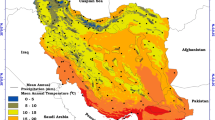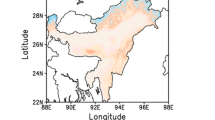Abstract
Recent global warming has caused significant changes to the regional climate over Eastern Canada and brought unprecedented challenges to the local communities, such as rising sea level, shrinking sea ice coverage, increasing coastal and inland floods, accelerated coastal erosion, and so on. Although local governments have declared climate emergency in recent years, there is still a lack of real climate actions due to the poor understanding of the future climatic changes over Eastern Canada and how to mitigate and adapt to those changes from a long-term perspective. Here we attempt to fill this gap by developing high-resolution regional climate scenarios for Eastern Canada throughout the twenty-first century under three greenhouse gases emission scenarios (RCP2.6—low, RCP4.5—medium, and RCP8.5—high). The results suggest that the low-emission scenario of RCP2.6 would potentially stabilize the regional climate (i.e., no significant changes in both temperature and precipitation) over Eastern Canada after the continuous warming reaches its peak in the middle of this century. However, an average warming about 1 °C would still be expected from now to the end of this century under RCP2.6, highlighting the importance of preparing for a new climate normal even though strict carbon reduction efforts could be made before 2050. In comparison, both RCP4.5 and RCP8.5 scenarios would lead to a continuous warming over Eastern Canada with increased total precipitation throughout this century. Most importantly, the warming trend under RCP8.5 is likely to accelerate after 2050, which would potentially cause significant shifts in the precipitation seasonality and bring more climate extremes, such as droughts in August, increasing spring and fall floods, more freezing rains between fall and winter, and more heavy snowfalls in winter. The results from this study can help the local policy makers understand the importance and scientific implications of taking immediate carbon reduction actions and developing long-term climate adaptation plans.















Similar content being viewed by others
Data availability
The gridded CRU dataset used in this study is available at: http://dx.doi.org/10.5285/10d3e3640f004c578403419aac167d82. The gridded climate dataset from the WorldClim version 2.0 is available at http://worldclim.org/version2.
References
AghaKouchak A, Chiang F, Huning LS, Love CA, Mallakpour I, Mazdiyasni O, Moftakhari H, Papalexiou SM, Ragno E, Sadegh M (2020) Climate extremes and compound hazards in a warming world. Annu Rev Earth Planet Sci 48:519–548
Barthel A, Agosta C, Little CM, Hattermann T, Jourdain NC, Goelzer H, Nowicki S, Seroussi H, Straneo F, Bracegirdle TJ (2020) CMIP5 model selection for ISMIP6 ice sheet model forcing: Greenland and Antarctica. Cryosphere 14(3):855–879
Bernier N, Thompson K (2007) Tide-surge interaction off the east coast of Canada and northeastern United States. J Geophys Res Oceans 112:C06008
Boon JD (2012) Evidence of sea level acceleration at US and Canadian tide stations, Atlantic Coast, North America. J Coast Res 28(6):1437–1445
Brander K (2010) Impacts of climate change on fisheries. J Mar Syst 79(3–4):389–402
Buttle JM, Allen DM, Caissie D, Davison B, Hayashi M, Peters DL, Pomeroy JW, Simonovic S, St-Hilaire A, Whitfield PH (2016) Flood processes in Canada: regional and special aspects. Can Water Resour J Revue Canadienne Des Ressources Hydriques 41(1–2):7–30
Clark NJ, Kerry JT, Fraser CI (2020) Rapid winter warming could disrupt coastal marine fish community structure. Nat Clim Change 10(9):862–867
Collins W, Bellouin N, Doutriaux-Boucher M, Gedney N, Hinton T, Jones C, Liddicoat S, Martin G, O’Connor F, Rae J (2008) Evaluation of the HadGEM2 model. Met Office, Exeter
Erler AR, Frey SK, Khader O, d’Orgeville M, Park YJ, Hwang HT, Lapen DR, Richard Peltier W, Sudicky EA (2019) Simulating climate change impacts on surface water resources within a lake-affected region using regional climate projections. Water Resour Res 55(1):130–155
Feser F, Rockel B, von Storch H, Winterfeldt J, Zahn M (2011) Regional climate models add value to global model data: a review and selected examples. Bull Am Meteorl Soc 92(9):1181–1192
Fick SE, Hijmans RJ (2017) WorldClim 2: new 1-km spatial resolution climate surfaces for global land areas. Int J Climatol 37(12):4302–4315
Graham RM, Cohen L, Petty AA, Boisvert LN, Rinke A, Hudson SR, Nicolaus M, Granskog MA (2017) Increasing frequency and duration of Arctic winter warming events. Geophys Res Lett 44(13):6974–6983
Guo J, Huang G, Wang X, Wu Y, Li Y, Zheng R, Song L (2020) Evaluating the added values of regional climate modeling over China at different resolutions. Sci Total Environ 718:137350
Harris I, Jones PD, Osborn TJ, Lister DH (2014) Updated high-resolution grids of monthly climatic observations–the CRU TS3. 10 Dataset. Int J Climatol 34(3):623–642
Johnston D, Friedlaender A, Torres L, Lavigne D (2005) Variation in sea ice cover on the east coast of Canada from 1969 to 2002: climate variability andimplications for harp and hooded seals. Clim Res 29(3):209–222
Jones R, Noguer M, Hassell D, Hudson D, Wilson S, Jenkins G, Mitchell J (2004) Generating high resolution climate change scenarios using PRECIS. Met Office Hadley Centre, Exeter, p 40
Jubb I, Canadell P, Dix M (2013) Representative concentration pathways (RCPs). Australian climate change science program, pp 5–7
Kang SM, Seager R, Frierson DM, Liu X (2015) Croll revisited: why is the northern hemisphere warmer than the southern hemisphere? Clim Dyn 44(5):1457–1472
King AD, Karoly DJ (2017) Climate extremes in Europe at 1.5 and 2 degrees of global warming. Environ Res Lett 12(11):114031
Kumar N, Tischbein B, Kusche J, Laux P, Beg MK, Bogardi JJ (2017) Impact of climate change on water resources of upper Kharun catchment in Chhattisgarh, India. J Hydrol Region Stud 13:189–207
MacMillan MR, Duarte C, Quijón PA (2017) Sandy beaches in a coastline vulnerable to erosion in Atlantic Canada: Macrobenthic community structure in relation to backshore and physical features. J Sea Res 125:26–33
McDermid J, Fera S, Hogg A (2015) Climate change projections for Ontario: an updated synthesis for policymakers and planners. Climate Change Research Report-Ontario Ministry of Natural Resources and Forestry (CCRR-44)
Mondal MS, Nowreen S, Sakib MN (2020) Scale-dependent reliability of projected rainfalls over Bangladesh with the PRECIS model. Climate 8(2):20
Niziol TA, Snyder WR, Waldstreicher JS (1995) Winter weather forecasting throughout the eastern United States, Part IV: lake effect snow. Weather Forec 10(1):61–77
Peace R Jr, Sykes R Jr (1966) Mesoscale study of a lake effect snow storm. Mon Weather Rev 94(8):495–507
Peltier WR, d’Orgeville M, Erler AR, Xie F (2018) Uncertainty in future summer precipitation in the Laurentian Great Lakes Basin: dynamical downscaling and the influence of continental-scale processes on regional climate change. J Clim 31(7):2651–2673
Perez J, Menendez M, Mendez FJ, Losada IJ (2014) Evaluating the performance of CMIP3 and CMIP5 global climate models over the north-east Atlantic region. Clim Dyn 43(9–10):2663–2680
Polyakov IV, Pnyushkov AV, Timokhov LA (2012) Warming of the intermediate Atlantic Water of the Arctic Ocean in the 2000s. J Clim 25(23):8362–8370
Rahel FJ, Olden JD (2008) Assessing the effects of climate change on aquatic invasive species. Conserv Biol 22(3):521–533
Rajbhandari R, Shrestha AB, Nepal S, Wahid S (2018) Projection of future precipitation and temperature change over the transboundary Koshi River basin using Regional Climate Model PRECIS. Atmos Clim Sci 8(02):163
Rangwala I, Sinsky E, Miller JR (2013) Amplified warming projections for high altitude regions of the northern hemisphere mid-latitudes from CMIP5 models. Environ Res Lett 8(2):024040
Reisinger A, Meinshausen M, Manning M (2011) Future changes in global warming potentials under representative concentration pathways. Environ Res Lett 6(2):024020
Sharma S, Blagrave K, Magnuson JJ, O’Reilly CM, Oliver S, Batt RD, Magee MR, Straile D, Weyhenmeyer GA, Winslow L (2019) Widespread loss of lake ice around the Northern Hemisphere in a warming world. Nat Clim Change 9(3):227–231
Thibodeau B, Not C, Zhu J, Schmittner A, Noone D, Tabor C, Zhang J, Liu Z (2018) Last century warming over the Canadian Atlantic shelves linked to weak Atlantic meridional overturning circulation. Geophys Res Lett 45(22):12376–312385
Van Vuuren DP, Edmonds J, Kainuma M, Riahi K, Thomson A, Hibbard K, Hurtt GC, Kram T, Krey V, Lamarque J-F (2011) The representative concentration pathways: an overview. Clim Change 109(1):5–31
Vasseur L, Catto N, Burton D, Chouinard O, Davies J, DeBaie L, Duclos G, Duinker P, Forbes D, Hermanutz L (2007) Atlantic Canada. In: From impacts to adaptation: Canada in a changing climate, pp 119–170
Wang X, Huang G, Liu J (2014a) Projected increases in intensity and frequency of rainfall extremes through a regional climate modeling approach. J Geophys Res Atmos 119(23):13271–213286
Wang X, Huang G, Lin Q, Liu J (2014b) High-resolution probabilistic projections of temperature changes over Ontario, Canada. J Clim 27(14):5259–5284
Wang X, Huang G, Liu J (2015a) Projected increases in near-surface air temperature over Ontario, Canada: a regional climate modeling approach. Clim Dyn 45(5):1381–1393
Wang X, Huang G, Liu J, Li Z, Zhao S (2015b) Ensemble projections of regional climatic changes over Ontario, Canada. J Clim 28(18):7327–7346
Wang X, Huang G, Liu J (2016) Twenty-first century probabilistic projections of precipitation over Ontario, Canada through a Regional Climate Model ensemble. Clim Dyn 46(11):3979–4001
Wheaton E, Kulshreshtha S, Wittrock V, Koshida G (2008) Dry times: hard lessons from the Canadian drought of 2001 and 2002. Can Geographer Le Géographe Canadien 52(2):241–262
Wilson S, Hassell D, Hein D, Jones R, Taylor R (2005) Installing and using the Hadley Centre regional climate modelling system, PRECIS. VeRsion 1(1):157
Wu Y, Guo J, Lin H, Bai J, Wang X (2021) Spatiotemporal patterns of future temperature and precipitation over China projected by PRECIS under RCPs. Atmos Res 249:105303
Zhang L, Zhao Y, Hein-Griggs D, Janes T, Tucker S, Ciborowski JJ (2020) Climate change projections of temperature and precipitation for the great lakes basin using the PRECIS regional climate model. J Great Lakes Res 46(2):255–266
Zhou X, Huang G, Baetz BW, Wang X, Cheng G (2018) PRECIS-projected increases in temperature and precipitation over Canada. Q J R Meteorol Soc 144(711):588–603
Zhu J, Huang G, Wang X, Cheng G, Wu Y (2018) High-resolution projections of mean and extreme precipitations over China through PRECIS under RCPs. Clim Dyn 50(11):4037–4060
Zhu H, Liu J, Zhou X, Chen X, Qiu X, Bello RL, Deng Z (2020) The Ontario Climate Data Portal, a user-friendly portal of Ontario-specific climate projections. Sci Data 7(1):1–10
Funding
This research was supported by the Natural Science and Engineering Research Council of Canada, the New Frontiers in Research Fund, and the Atlantic Computational Excellence Network (ACENET).
Author information
Authors and Affiliations
Corresponding author
Ethics declarations
Conflict of interest
The authors have no relevant financial or non-financial interests to disclose.
Additional information
Publisher's Note
Springer Nature remains neutral with regard to jurisdictional claims in published maps and institutional affiliations.
Rights and permissions
About this article
Cite this article
Wang, X., Guo, J., Fenech, A. et al. Future climate projections for Eastern Canada. Clim Dyn 59, 2735–2750 (2022). https://doi.org/10.1007/s00382-022-06251-y
Received:
Accepted:
Published:
Issue Date:
DOI: https://doi.org/10.1007/s00382-022-06251-y




